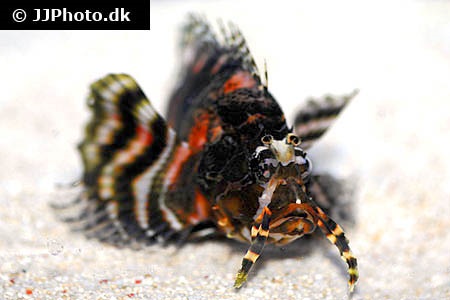Dendrochirus biocellatus

| Latin name | Dendrochirus biocellatus - (Fowler, 1938) |
|---|---|
| Local name | Twospot turkeyfish |
| Family | Scorpaenidae - Dendrochirus |
| Origin | East Indian Ocean, West Indian Ocean, Australia, Indonesia, East Pacific, Central/West Pacific |
| Max length | 13 cm (5.1") |
| Minimum volume |
100 l (26 gal) |
|---|---|
| Hardiness |
Hardy |
| Suitable for aquarium |
Suitable with care |
| Reef safe |
Reef safe with caution |
| Aggressiveness | Mostly peaceful but might be aggressive towards similar species |
| Recommended |
Fish Larger crustaceans (Shrimp, crabs...) |
|---|
This species will require living foods, as it will typically reject "dead" foods.
This species is highly venomous and this venom can, under certain circumstances, be fatal.
In case of poisoning, it is vital to have as much information as possible regarding the species/poison. Have telephone number for the poison hotline close to the aquarium.
Since people can have different reactions to poisons, take precautions necessary to ensure your safety and that of your surroundings.
These fish flourish better without other members of the same species in the aquarium.
These fish prefer live feed, such as live fish or shrimp. Some specimens refuse "dead" food altogether, while others can be trained to accept it.
Its easiest to move the frozen food around in front of the fish with a pair of tweezers. As soon as the fish shows interest and “attacks”, let go of the food.
They will try to eat all fish, shrimps and similar life forms that are small enough to fit in itheir mouth.
They should be fed a couple of times a week.
The fish and shrimps used as foods, must remain whole to give the Lionfish the optimum nutrition. The food must not be thawed naturaly, this helps to retain all the goodness.
Suitable live food are: Mollies, Guppies and Ghostshrimp. The feeder fish or shrimp should be fed with nutritious feed, like Cyclop-eeze for example.
This species thrives best in an aquarium with overhangs and caves.
This species is nocturnal and therefore the most active when the light is dimmed or turned off.
Scorpion-/Lionfish (Scorpaenidae) are both pretty and interesting because of their special appearance and behaviour.
They are generally hardy and do not need a large swimming area, but do often require feeding with small live fish and/or shrimps. Some will quickly begin eating frozen fish or shrimp whilst others will refuse to eat "dead" food. Their food must be highly nutritious and varied. They must not be fed too often. Feed them a large meal twice a week.
These fish are mostly peaceful, but will eat anything that fits into their mouth. One might be surprised by how large their prey can be, they can even swallow fish which nearly match their own length. They will also eat each other, if the size difference is large enough. Their venomous spines do not guarantee that they will not be eaten by other predatory fishes.
Do be cautious when having your hands in the aquarium as these fish are very poisonous.
Some Scorpionfish require a special substrate, either coral gravel or fine sand, as this resembles their natural habitat.
Be careful when catching Scorpion-/Lionfish as they can easily get caught in the net.
| Aquarium trade | Yes |
|---|---|
| Distribution | Indo-Pacific: Mauritius, Reunion, Maldives and Sri Lanka (Ref. 33390) to the Society Islands, north to southern Japan, south to Scott Reef. |
| English common names |
Twinspot lionfish Ocellated lionfish |
| Danish common names |
Toplettet dragefisk |
| French common names |
Ptérois ocellé |
Erin Spencer. 2013. The Truth About Getting Stung by a Lionfish - National Geographic - (English)
Scott W. Michael. 2001. Reef Fishes volume 1 - TFH Publications / Microcosm Ltd. - (English)
Henry C. Schultz. 2002. Scorpionfish: Masters of Camouflage - Reefkeeping Magazine - (English)
Greg and Renee Hix. Scorpionfish in the Home Aquarium - Lionfish Lair - (English)
Greg and Renee Hix. Lionfish in the Home Aquarium - Lionfish Lair - (English)
Daniel Pomfret- 2007. Venomous Beauties: A Look at Scorpionfishes in the Home Aquarium - Tropical Fish Hobbyist Magazine - (English)

